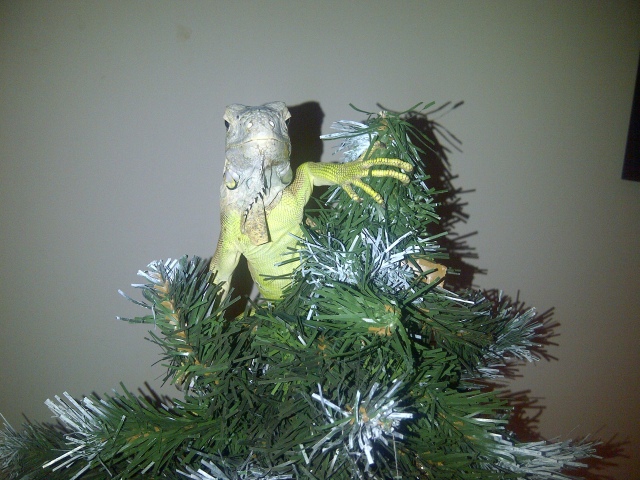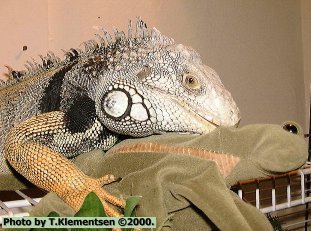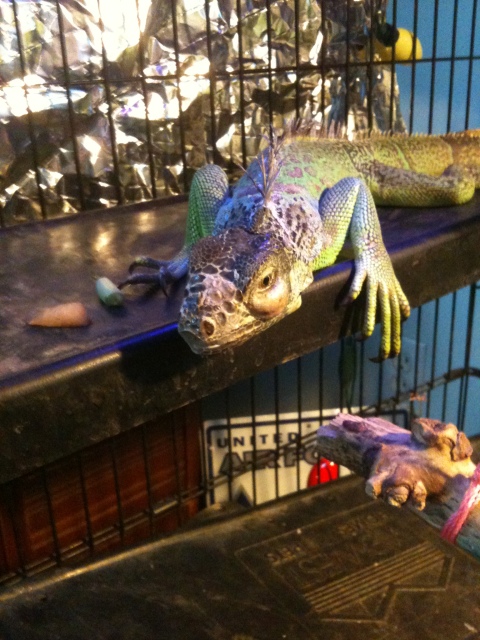QuestionQUESTION: I was about to leave when I heard a clash in my room from my cat, thinking she just jumped on my desk and messed up my desk supplies. I run in and I see my cat scurry across the room and my iguana running for its life. I see her play bite my iguana and I grabbed my cat and tossed her out the room. Devastated, I went to my iguana under the bed as it just layed in shock. I saw its leg was broken, and I carefully lifted her to my palm. she moved to find safety on my arm, but her leg rolled under her. What I described was all i saw happen, but i think her leg was broken from my cat maybe biting her leg and throwing her off the desk. when i saw her bite her, it was light and only scratched her back. there is no bleeding anywhere or puncture wounds. I dont know how my cat got in or my iguana out. My cage has a locking top but when i looked at it, it was open, so ill never know. my iguana is about 6 months old, only 11 inches tail and all. I called the vet and there wasnt much they could guarantee, except an unaffordable charge. im so upset, but its been about 5 hours since the incident, and shes still bright green. she has dark spots where she was injured, and her leg is swolen, her knee also looks out of place. shes very calm and alert. please tell me what else i can do, i just want her to live, i love her so much.
ANSWER: Dear Ashley,
Ok, this sort of thing happens more than you would think where iguanas break bones, tear ligaments, etc. whether it be in a scuffle with another animal or from any other random household accident. Here is what I have learned from dealing with various captive iguana injuries and observing iguanas in the wild:
Any animal that is able to regenerate a body part is able to heal quickly and withstand injury quite well.
Now, ideally, if money wasn't an issue and you had an outstanding reptile vet, you could expect to have the leg set in either a splint or a cast or even have surgery performed to put pins in place, etc...as if it were a human bone break. This is completely unnecessary unless you are worried about cosmetic concerns, because it is not a life or death kind of procedure. The worst case scenario would be that the leg heals improperly and the iguana either develops a limp or disfigured knee/leg. If your iguana is still walking on the leg, then the chances of that are not as high because it is still somewhat in place to allow for walking. Also, the other worst case scenario would be that the joint or injury becomes septic and seeps into the blood, which is rare, but fatal.
The only thing that I do for injuries like this is get antibiotics like "baytril or cipro" and the pain reliever "metacam" and syringe it into the iguana's mouth for about a month or so, that way it brings swelling down and helps them with pain so they heal faster and eliminates the possibility of developing a septic joint. When an iguana is in pain, it won't want to eat as much and it won't be very active, so it helps them feel better. Do not attempt to administer any human drugs to the iguana because their bodies are so different than ours and some drugs we use can kill them or damage their livers and kidneys badly.
The most important thing to do for the injured iguana is to keep her in a small enclosure where she doesn't have the option of getting hurt, somewhere she can't climb really high and jump down from something, just a typical cage with food, water and possibly a short branch. Broken bones usually heal in 6 weeks and torn ligaments/tendons in 12, so isolate her for about a month and see if you can't get your vet to prescribe some baytril and/or metacam. The dosages should be very small because she is so young. Also, remember, because she is so young and resilient, she should be just fine. Avoid handling her and keep her warm so her immune system is strong. Make sure you've got her a good UVB source also, because without UVB iguanas cannot digest calcium and without calcium, her bones cannot be strong.
Please reply back with any further questions.
Thanks,
Sara Gwerder
President
Raptor Rescue Iguana Sanctuary
Shreveport, LA
www.RaptorRescue.org
---------- FOLLOW-UP ----------
QUESTION: Thank you so much for your help, I had asked a few other people but they basically repremanded me for not bringing her to a vet. I felt terrible that I couldn't, but i'm only a student and working very few hours due to the economy.
Its been almost 3 days now and I have only seen things get better for her. A few hours after the incident I saw that the areas where she was injured became darkened, almost like a bruise. I took everything out of her cage except for her hammock(that i moved down just slightly above the floor), her food bowls and water. She moves around and scratches on the glass wanting to get out. She even ate the day she was injured. But now that shes had some time to heal, the darkened areas are almost completely gone, even the scratches. However, I believe I was right when I assumed my cat had grabbed her leg, because there is a dot above and below her knee. The swelling though has reduced as well, and she has plenty of calcium, uvb, heat, and food. I'm going to look into the pain medicines, but does it seem like she's in pain by my description?
And also, if her inury becomes septic, would I see signs by now?
Thank you soo much!
AnswerInteresting description of the injury... a dot above and below the knee might indicate she was bit and she has a soft tissue injury. I think from what you are saying, if she is still eating and has some energy and hasn't completely become lethargic and weak, she should be just fine. Septic joints are rare but you can tell if you are dealing with one if it is swollen badly and hot to the touch. I think the pain medicine is probably not worth buying at this point because sounds like the pain is subsiding and the injury is healing so the worst is probably over. You asked about whether or not it sounds like she is in pain, and I will leave you to decide that by telling you what iguanas usually act like when they are in pain: very lethargic, no appetite, and often it appears they keep swallowing if you are messing with the injured area. Iguanas are not made to show when they are in pain because in the wild, a weak iguana is an easy target, so it is hard to tell the true extent of their pain. Generally speaking, the higher the pain level, the lower the energy level in the iguana. Just keep monitoring the injury and watch to see what happens, if the swelling goes down and she seems to be walking on it fine and eating fine, she may be ready to go back to her usual routine, but if it remains swollen, bruised and if she starts to appear weak or have loss of appetite, you may want to become more concerned. Honestly, iguanas in the wild become injured so often and they are really tough creatures if they are getting a good diet, proper lighting, enough heat and a good, steady sleep cycle. They are hearty creatures and can overcome serious injury quite well. Please keep in contact if you have any new concerns.
Sara

 My pet iguana
Question
My iguana tail
My iguana wa trying to r
My pet iguana
Question
My iguana tail
My iguana wa trying to r
 sexing
QuestionGarth on the christmas
QUESTION: Hi i ad
sexing
QuestionGarth on the christmas
QUESTION: Hi i ad
 rescued iguana
Question
2 Igs
Hello! We rescued a small green iguana t
rescued iguana
Question
2 Igs
Hello! We rescued a small green iguana t
 My ig is driving me crazy!!!!!
QuestionQUESTION: Ok We are almost positive that he is
My ig is driving me crazy!!!!!
QuestionQUESTION: Ok We are almost positive that he is
 Green Iguana Godzilla Swollen Under Eye
Question
Godzilla Left Eye Chee
Our green iguana
Green Iguana Godzilla Swollen Under Eye
Question
Godzilla Left Eye Chee
Our green iguana